Next Generation Sequencing Technology
VerifiedAdded on 2023/04/20
|15
|4409
|425
AI Summary
This article explores the applications of Next Generation Sequencing (NGS) technology in cancer research and diagnosis. It discusses the role of gene mutations in cancer development and highlights the importance of NGS in analyzing human genomes to advance our understanding of cancer. The article also focuses on the use of NGS in mutational profiling and its application in the research of breast and prostate cancer.
Contribute Materials
Your contribution can guide someone’s learning journey. Share your
documents today.
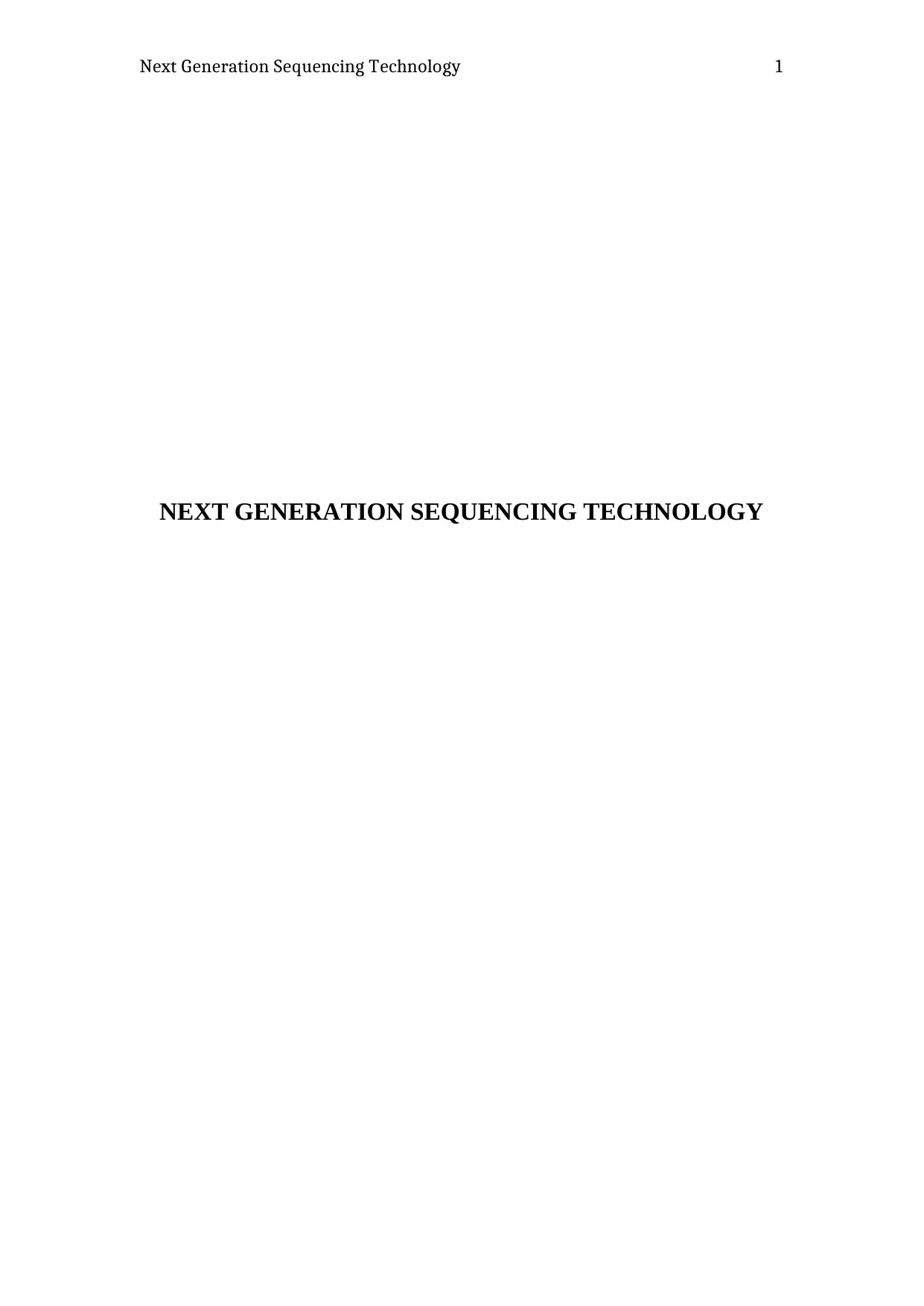
Next Generation Sequencing Technology
NEXT GENERATION SEQUENCING TECHNOLOGY
1
NEXT GENERATION SEQUENCING TECHNOLOGY
1
Secure Best Marks with AI Grader
Need help grading? Try our AI Grader for instant feedback on your assignments.
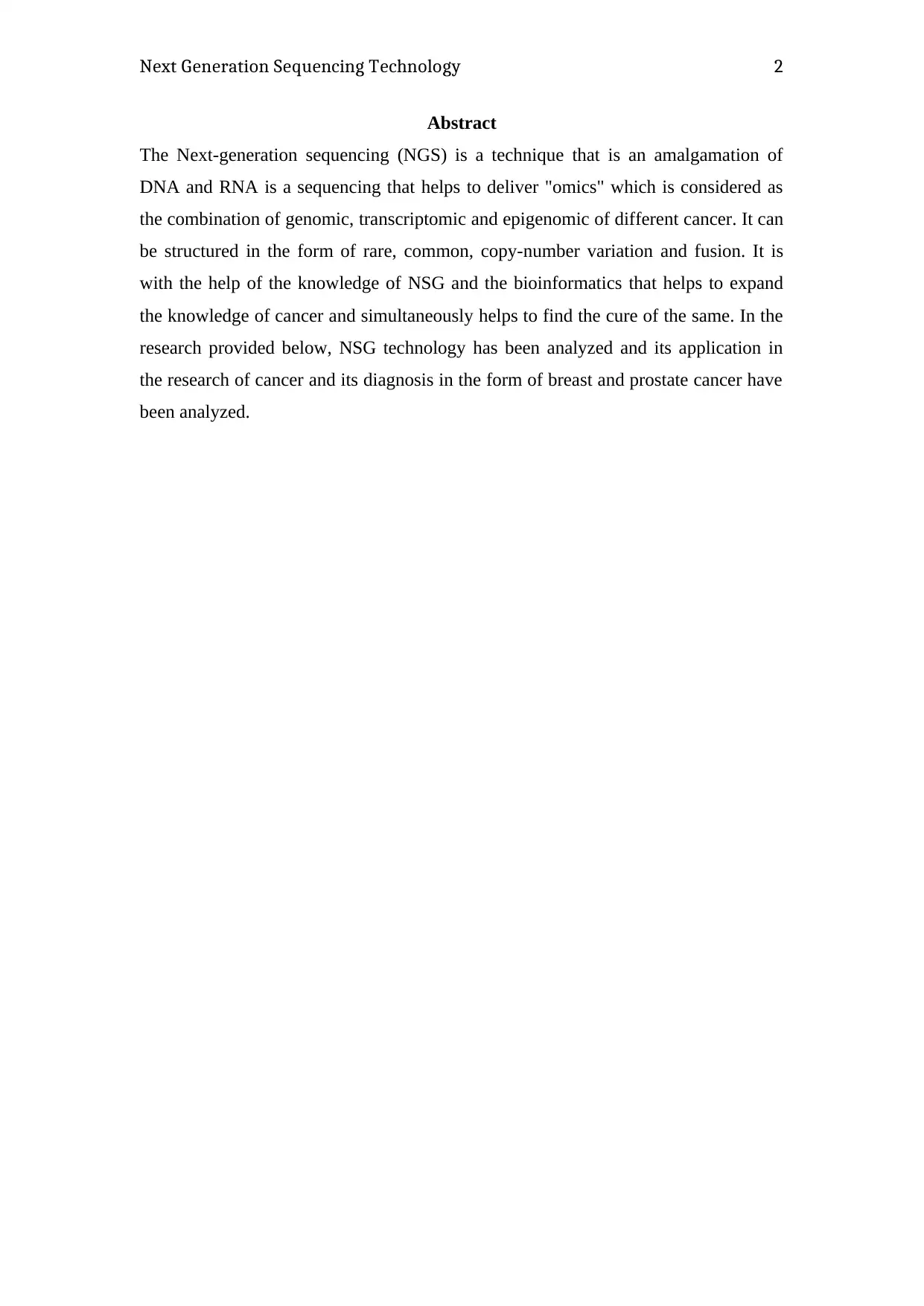
Next Generation Sequencing Technology
Abstract
The Next-generation sequencing (NGS) is a technique that is an amalgamation of
DNA and RNA is a sequencing that helps to deliver "omics" which is considered as
the combination of genomic, transcriptomic and epigenomic of different cancer. It can
be structured in the form of rare, common, copy-number variation and fusion. It is
with the help of the knowledge of NSG and the bioinformatics that helps to expand
the knowledge of cancer and simultaneously helps to find the cure of the same. In the
research provided below, NSG technology has been analyzed and its application in
the research of cancer and its diagnosis in the form of breast and prostate cancer have
been analyzed.
2
Abstract
The Next-generation sequencing (NGS) is a technique that is an amalgamation of
DNA and RNA is a sequencing that helps to deliver "omics" which is considered as
the combination of genomic, transcriptomic and epigenomic of different cancer. It can
be structured in the form of rare, common, copy-number variation and fusion. It is
with the help of the knowledge of NSG and the bioinformatics that helps to expand
the knowledge of cancer and simultaneously helps to find the cure of the same. In the
research provided below, NSG technology has been analyzed and its application in
the research of cancer and its diagnosis in the form of breast and prostate cancer have
been analyzed.
2
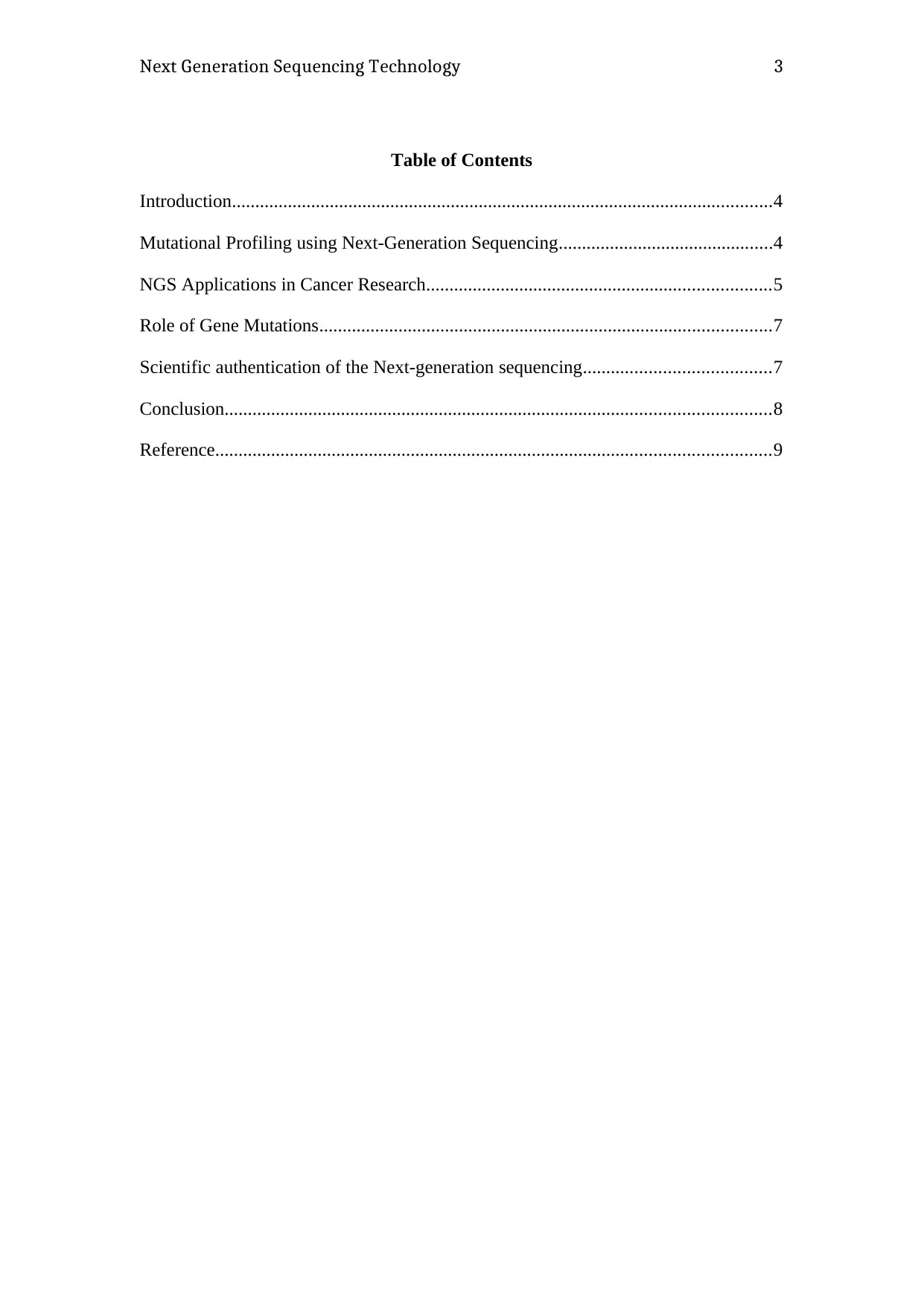
Next Generation Sequencing Technology
Table of Contents
Introduction....................................................................................................................4
Mutational Profiling using Next-Generation Sequencing..............................................4
NGS Applications in Cancer Research..........................................................................5
Role of Gene Mutations.................................................................................................7
Scientific authentication of the Next-generation sequencing........................................7
Conclusion.....................................................................................................................8
Reference.......................................................................................................................9
3
Table of Contents
Introduction....................................................................................................................4
Mutational Profiling using Next-Generation Sequencing..............................................4
NGS Applications in Cancer Research..........................................................................5
Role of Gene Mutations.................................................................................................7
Scientific authentication of the Next-generation sequencing........................................7
Conclusion.....................................................................................................................8
Reference.......................................................................................................................9
3
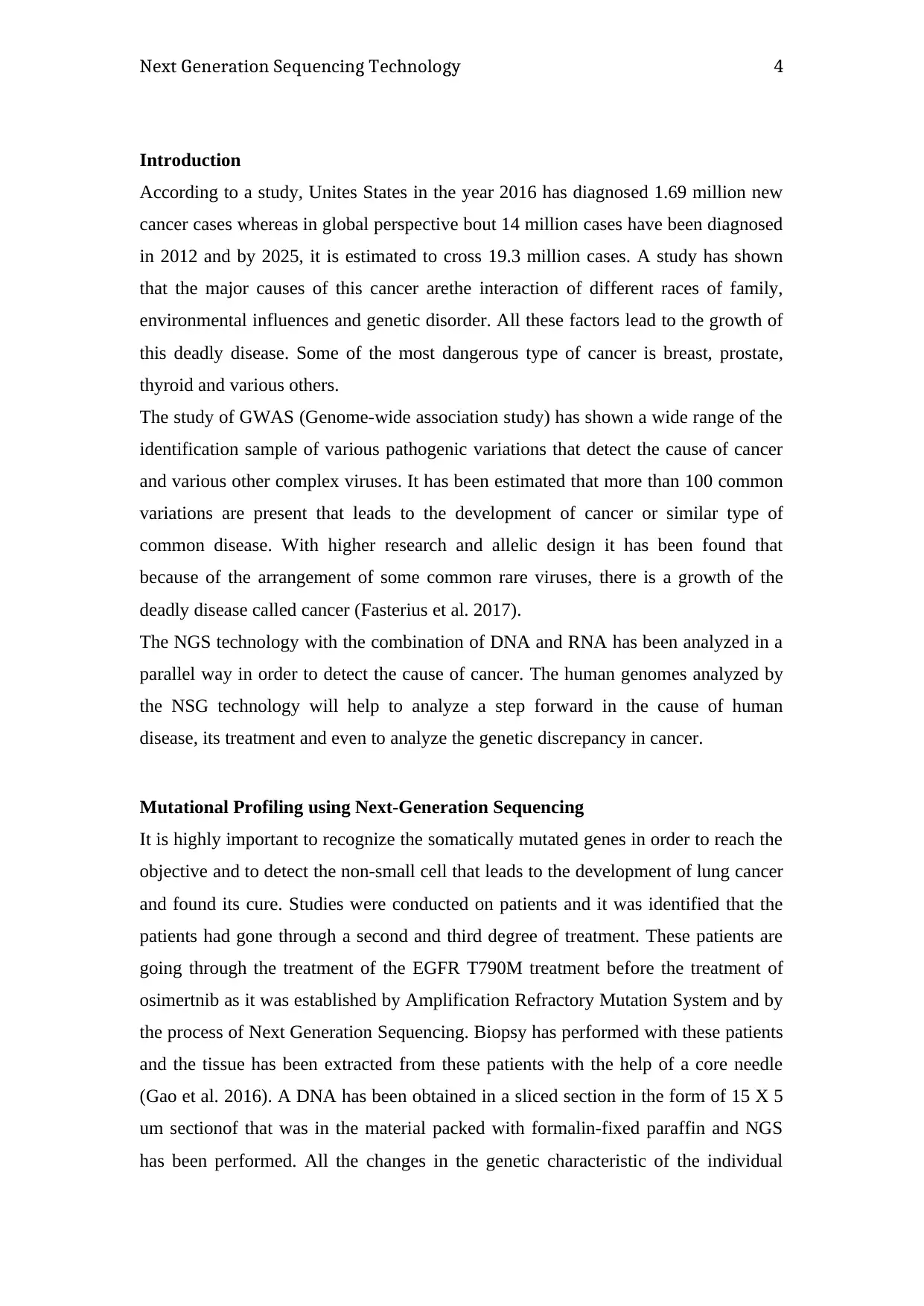
Next Generation Sequencing Technology
Introduction
According to a study, Unites States in the year 2016 has diagnosed 1.69 million new
cancer cases whereas in global perspective bout 14 million cases have been diagnosed
in 2012 and by 2025, it is estimated to cross 19.3 million cases. A study has shown
that the major causes of this cancer arethe interaction of different races of family,
environmental influences and genetic disorder. All these factors lead to the growth of
this deadly disease. Some of the most dangerous type of cancer is breast, prostate,
thyroid and various others.
The study of GWAS (Genome-wide association study) has shown a wide range of the
identification sample of various pathogenic variations that detect the cause of cancer
and various other complex viruses. It has been estimated that more than 100 common
variations are present that leads to the development of cancer or similar type of
common disease. With higher research and allelic design it has been found that
because of the arrangement of some common rare viruses, there is a growth of the
deadly disease called cancer (Fasterius et al. 2017).
The NGS technology with the combination of DNA and RNA has been analyzed in a
parallel way in order to detect the cause of cancer. The human genomes analyzed by
the NSG technology will help to analyze a step forward in the cause of human
disease, its treatment and even to analyze the genetic discrepancy in cancer.
Mutational Profiling using Next-Generation Sequencing
It is highly important to recognize the somatically mutated genes in order to reach the
objective and to detect the non-small cell that leads to the development of lung cancer
and found its cure. Studies were conducted on patients and it was identified that the
patients had gone through a second and third degree of treatment. These patients are
going through the treatment of the EGFR T790M treatment before the treatment of
osimertnib as it was established by Amplification Refractory Mutation System and by
the process of Next Generation Sequencing. Biopsy has performed with these patients
and the tissue has been extracted from these patients with the help of a core needle
(Gao et al. 2016). A DNA has been obtained in a sliced section in the form of 15 X 5
um sectionof that was in the material packed with formalin-fixed paraffin and NGS
has been performed. All the changes in the genetic characteristic of the individual
4
Introduction
According to a study, Unites States in the year 2016 has diagnosed 1.69 million new
cancer cases whereas in global perspective bout 14 million cases have been diagnosed
in 2012 and by 2025, it is estimated to cross 19.3 million cases. A study has shown
that the major causes of this cancer arethe interaction of different races of family,
environmental influences and genetic disorder. All these factors lead to the growth of
this deadly disease. Some of the most dangerous type of cancer is breast, prostate,
thyroid and various others.
The study of GWAS (Genome-wide association study) has shown a wide range of the
identification sample of various pathogenic variations that detect the cause of cancer
and various other complex viruses. It has been estimated that more than 100 common
variations are present that leads to the development of cancer or similar type of
common disease. With higher research and allelic design it has been found that
because of the arrangement of some common rare viruses, there is a growth of the
deadly disease called cancer (Fasterius et al. 2017).
The NGS technology with the combination of DNA and RNA has been analyzed in a
parallel way in order to detect the cause of cancer. The human genomes analyzed by
the NSG technology will help to analyze a step forward in the cause of human
disease, its treatment and even to analyze the genetic discrepancy in cancer.
Mutational Profiling using Next-Generation Sequencing
It is highly important to recognize the somatically mutated genes in order to reach the
objective and to detect the non-small cell that leads to the development of lung cancer
and found its cure. Studies were conducted on patients and it was identified that the
patients had gone through a second and third degree of treatment. These patients are
going through the treatment of the EGFR T790M treatment before the treatment of
osimertnib as it was established by Amplification Refractory Mutation System and by
the process of Next Generation Sequencing. Biopsy has performed with these patients
and the tissue has been extracted from these patients with the help of a core needle
(Gao et al. 2016). A DNA has been obtained in a sliced section in the form of 15 X 5
um sectionof that was in the material packed with formalin-fixed paraffin and NGS
has been performed. All the changes in the genetic characteristic of the individual
4
Secure Best Marks with AI Grader
Need help grading? Try our AI Grader for instant feedback on your assignments.
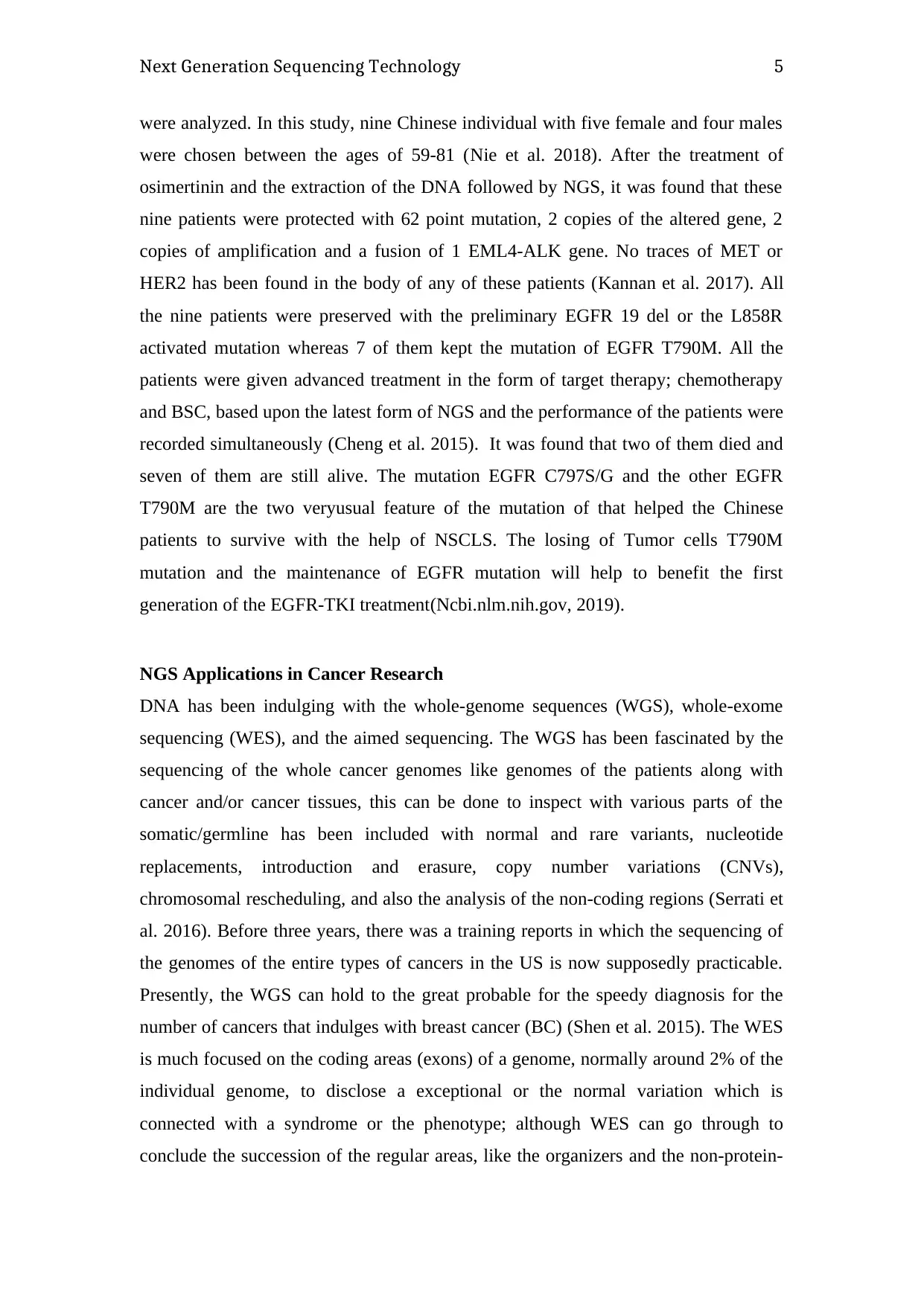
Next Generation Sequencing Technology
were analyzed. In this study, nine Chinese individual with five female and four males
were chosen between the ages of 59-81 (Nie et al. 2018). After the treatment of
osimertinin and the extraction of the DNA followed by NGS, it was found that these
nine patients were protected with 62 point mutation, 2 copies of the altered gene, 2
copies of amplification and a fusion of 1 EML4-ALK gene. No traces of MET or
HER2 has been found in the body of any of these patients (Kannan et al. 2017). All
the nine patients were preserved with the preliminary EGFR 19 del or the L858R
activated mutation whereas 7 of them kept the mutation of EGFR T790M. All the
patients were given advanced treatment in the form of target therapy; chemotherapy
and BSC, based upon the latest form of NGS and the performance of the patients were
recorded simultaneously (Cheng et al. 2015). It was found that two of them died and
seven of them are still alive. The mutation EGFR C797S/G and the other EGFR
T790M are the two veryusual feature of the mutation of that helped the Chinese
patients to survive with the help of NSCLS. The losing of Tumor cells T790M
mutation and the maintenance of EGFR mutation will help to benefit the first
generation of the EGFR-TKI treatment(Ncbi.nlm.nih.gov, 2019).
NGS Applications in Cancer Research
DNA has been indulging with the whole-genome sequences (WGS), whole-exome
sequencing (WES), and the aimed sequencing. The WGS has been fascinated by the
sequencing of the whole cancer genomes like genomes of the patients along with
cancer and/or cancer tissues, this can be done to inspect with various parts of the
somatic/germline has been included with normal and rare variants, nucleotide
replacements, introduction and erasure, copy number variations (CNVs),
chromosomal rescheduling, and also the analysis of the non-coding regions (Serrati et
al. 2016). Before three years, there was a training reports in which the sequencing of
the genomes of the entire types of cancers in the US is now supposedly practicable.
Presently, the WGS can hold to the great probable for the speedy diagnosis for the
number of cancers that indulges with breast cancer (BC) (Shen et al. 2015). The WES
is much focused on the coding areas (exons) of a genome, normally around 2% of the
individual genome, to disclose a exceptional or the normal variation which is
connected with a syndrome or the phenotype; although WES can go through to
conclude the succession of the regular areas, like the organizers and the non-protein-
5
were analyzed. In this study, nine Chinese individual with five female and four males
were chosen between the ages of 59-81 (Nie et al. 2018). After the treatment of
osimertinin and the extraction of the DNA followed by NGS, it was found that these
nine patients were protected with 62 point mutation, 2 copies of the altered gene, 2
copies of amplification and a fusion of 1 EML4-ALK gene. No traces of MET or
HER2 has been found in the body of any of these patients (Kannan et al. 2017). All
the nine patients were preserved with the preliminary EGFR 19 del or the L858R
activated mutation whereas 7 of them kept the mutation of EGFR T790M. All the
patients were given advanced treatment in the form of target therapy; chemotherapy
and BSC, based upon the latest form of NGS and the performance of the patients were
recorded simultaneously (Cheng et al. 2015). It was found that two of them died and
seven of them are still alive. The mutation EGFR C797S/G and the other EGFR
T790M are the two veryusual feature of the mutation of that helped the Chinese
patients to survive with the help of NSCLS. The losing of Tumor cells T790M
mutation and the maintenance of EGFR mutation will help to benefit the first
generation of the EGFR-TKI treatment(Ncbi.nlm.nih.gov, 2019).
NGS Applications in Cancer Research
DNA has been indulging with the whole-genome sequences (WGS), whole-exome
sequencing (WES), and the aimed sequencing. The WGS has been fascinated by the
sequencing of the whole cancer genomes like genomes of the patients along with
cancer and/or cancer tissues, this can be done to inspect with various parts of the
somatic/germline has been included with normal and rare variants, nucleotide
replacements, introduction and erasure, copy number variations (CNVs),
chromosomal rescheduling, and also the analysis of the non-coding regions (Serrati et
al. 2016). Before three years, there was a training reports in which the sequencing of
the genomes of the entire types of cancers in the US is now supposedly practicable.
Presently, the WGS can hold to the great probable for the speedy diagnosis for the
number of cancers that indulges with breast cancer (BC) (Shen et al. 2015). The WES
is much focused on the coding areas (exons) of a genome, normally around 2% of the
individual genome, to disclose a exceptional or the normal variation which is
connected with a syndrome or the phenotype; although WES can go through to
conclude the succession of the regular areas, like the organizers and the non-protein-
5
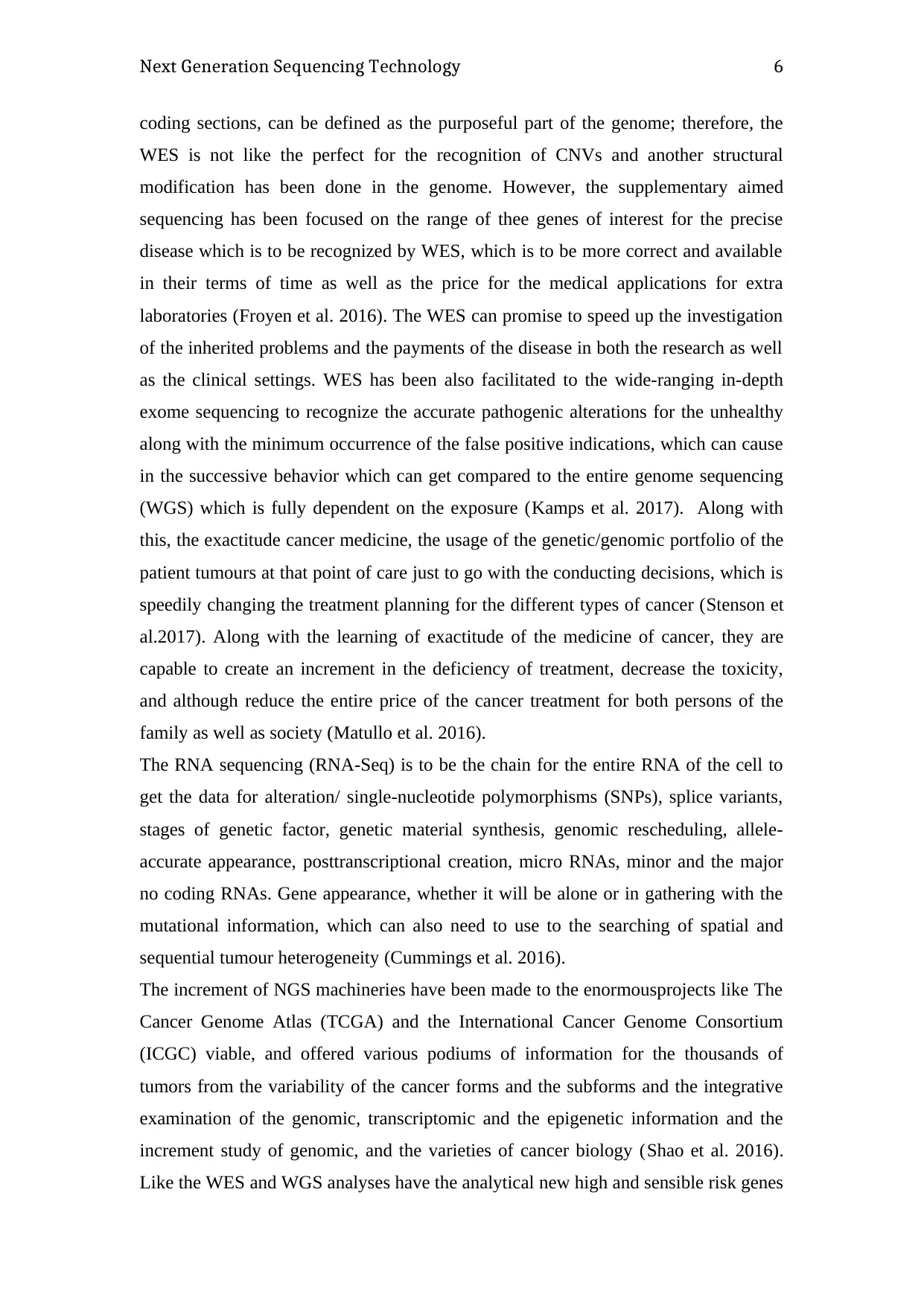
Next Generation Sequencing Technology
coding sections, can be defined as the purposeful part of the genome; therefore, the
WES is not like the perfect for the recognition of CNVs and another structural
modification has been done in the genome. However, the supplementary aimed
sequencing has been focused on the range of thee genes of interest for the precise
disease which is to be recognized by WES, which is to be more correct and available
in their terms of time as well as the price for the medical applications for extra
laboratories (Froyen et al. 2016). The WES can promise to speed up the investigation
of the inherited problems and the payments of the disease in both the research as well
as the clinical settings. WES has been also facilitated to the wide-ranging in-depth
exome sequencing to recognize the accurate pathogenic alterations for the unhealthy
along with the minimum occurrence of the false positive indications, which can cause
in the successive behavior which can get compared to the entire genome sequencing
(WGS) which is fully dependent on the exposure (Kamps et al. 2017). Along with
this, the exactitude cancer medicine, the usage of the genetic/genomic portfolio of the
patient tumours at that point of care just to go with the conducting decisions, which is
speedily changing the treatment planning for the different types of cancer (Stenson et
al.2017). Along with the learning of exactitude of the medicine of cancer, they are
capable to create an increment in the deficiency of treatment, decrease the toxicity,
and although reduce the entire price of the cancer treatment for both persons of the
family as well as society (Matullo et al. 2016).
The RNA sequencing (RNA-Seq) is to be the chain for the entire RNA of the cell to
get the data for alteration/ single-nucleotide polymorphisms (SNPs), splice variants,
stages of genetic factor, genetic material synthesis, genomic rescheduling, allele-
accurate appearance, posttranscriptional creation, micro RNAs, minor and the major
no coding RNAs. Gene appearance, whether it will be alone or in gathering with the
mutational information, which can also need to use to the searching of spatial and
sequential tumour heterogeneity (Cummings et al. 2016).
The increment of NGS machineries have been made to the enormousprojects like The
Cancer Genome Atlas (TCGA) and the International Cancer Genome Consortium
(ICGC) viable, and offered various podiums of information for the thousands of
tumors from the variability of the cancer forms and the subforms and the integrative
examination of the genomic, transcriptomic and the epigenetic information and the
increment study of genomic, and the varieties of cancer biology (Shao et al. 2016).
Like the WES and WGS analyses have the analytical new high and sensible risk genes
6
coding sections, can be defined as the purposeful part of the genome; therefore, the
WES is not like the perfect for the recognition of CNVs and another structural
modification has been done in the genome. However, the supplementary aimed
sequencing has been focused on the range of thee genes of interest for the precise
disease which is to be recognized by WES, which is to be more correct and available
in their terms of time as well as the price for the medical applications for extra
laboratories (Froyen et al. 2016). The WES can promise to speed up the investigation
of the inherited problems and the payments of the disease in both the research as well
as the clinical settings. WES has been also facilitated to the wide-ranging in-depth
exome sequencing to recognize the accurate pathogenic alterations for the unhealthy
along with the minimum occurrence of the false positive indications, which can cause
in the successive behavior which can get compared to the entire genome sequencing
(WGS) which is fully dependent on the exposure (Kamps et al. 2017). Along with
this, the exactitude cancer medicine, the usage of the genetic/genomic portfolio of the
patient tumours at that point of care just to go with the conducting decisions, which is
speedily changing the treatment planning for the different types of cancer (Stenson et
al.2017). Along with the learning of exactitude of the medicine of cancer, they are
capable to create an increment in the deficiency of treatment, decrease the toxicity,
and although reduce the entire price of the cancer treatment for both persons of the
family as well as society (Matullo et al. 2016).
The RNA sequencing (RNA-Seq) is to be the chain for the entire RNA of the cell to
get the data for alteration/ single-nucleotide polymorphisms (SNPs), splice variants,
stages of genetic factor, genetic material synthesis, genomic rescheduling, allele-
accurate appearance, posttranscriptional creation, micro RNAs, minor and the major
no coding RNAs. Gene appearance, whether it will be alone or in gathering with the
mutational information, which can also need to use to the searching of spatial and
sequential tumour heterogeneity (Cummings et al. 2016).
The increment of NGS machineries have been made to the enormousprojects like The
Cancer Genome Atlas (TCGA) and the International Cancer Genome Consortium
(ICGC) viable, and offered various podiums of information for the thousands of
tumors from the variability of the cancer forms and the subforms and the integrative
examination of the genomic, transcriptomic and the epigenetic information and the
increment study of genomic, and the varieties of cancer biology (Shao et al. 2016).
Like the WES and WGS analyses have the analytical new high and sensible risk genes
6
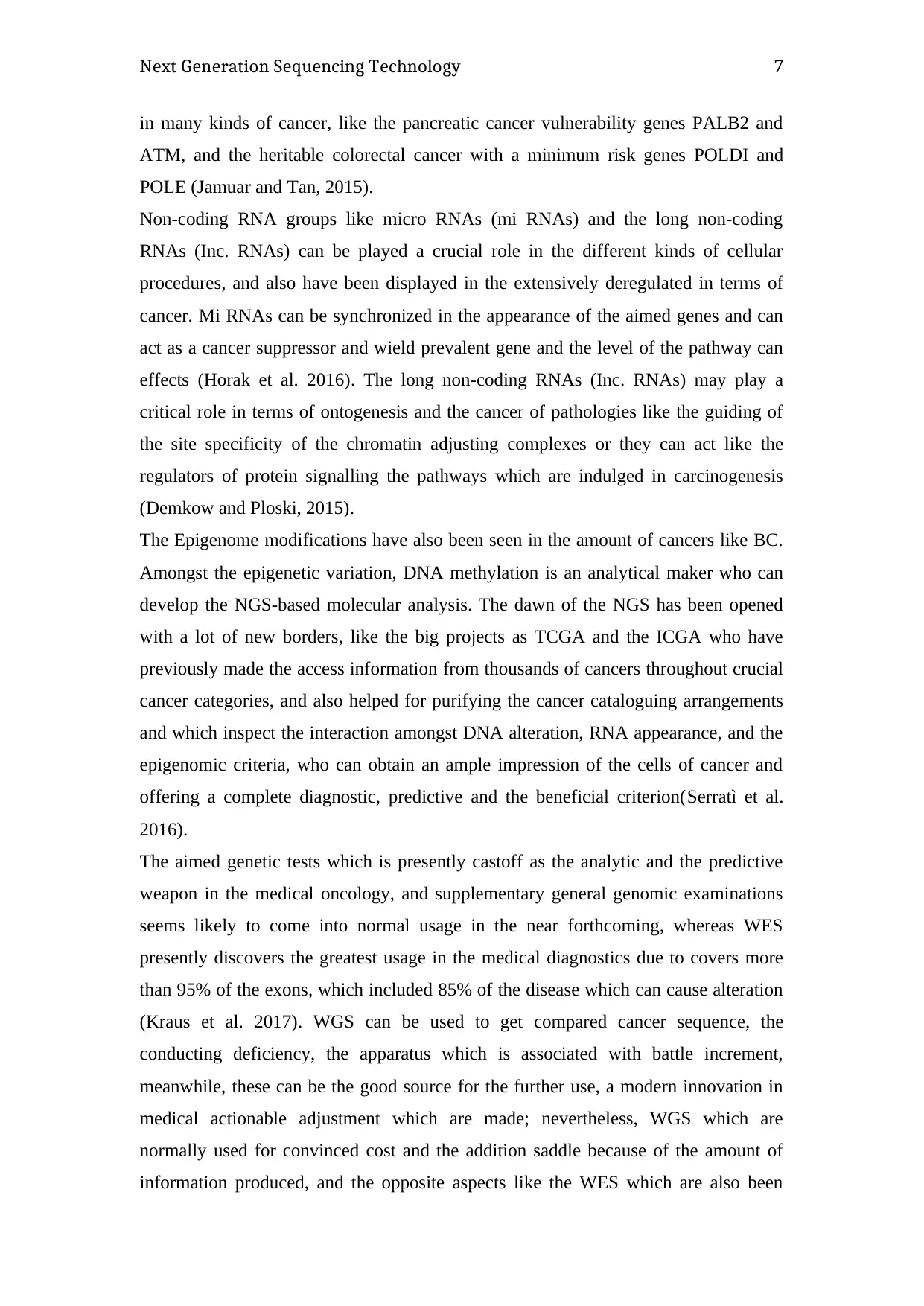
Next Generation Sequencing Technology
in many kinds of cancer, like the pancreatic cancer vulnerability genes PALB2 and
ATM, and the heritable colorectal cancer with a minimum risk genes POLDI and
POLE (Jamuar and Tan, 2015).
Non-coding RNA groups like micro RNAs (mi RNAs) and the long non-coding
RNAs (Inc. RNAs) can be played a crucial role in the different kinds of cellular
procedures, and also have been displayed in the extensively deregulated in terms of
cancer. Mi RNAs can be synchronized in the appearance of the aimed genes and can
act as a cancer suppressor and wield prevalent gene and the level of the pathway can
effects (Horak et al. 2016). The long non-coding RNAs (Inc. RNAs) may play a
critical role in terms of ontogenesis and the cancer of pathologies like the guiding of
the site specificity of the chromatin adjusting complexes or they can act like the
regulators of protein signalling the pathways which are indulged in carcinogenesis
(Demkow and Ploski, 2015).
The Epigenome modifications have also been seen in the amount of cancers like BC.
Amongst the epigenetic variation, DNA methylation is an analytical maker who can
develop the NGS-based molecular analysis. The dawn of the NGS has been opened
with a lot of new borders, like the big projects as TCGA and the ICGA who have
previously made the access information from thousands of cancers throughout crucial
cancer categories, and also helped for purifying the cancer cataloguing arrangements
and which inspect the interaction amongst DNA alteration, RNA appearance, and the
epigenomic criteria, who can obtain an ample impression of the cells of cancer and
offering a complete diagnostic, predictive and the beneficial criterion(Serratì et al.
2016).
The aimed genetic tests which is presently castoff as the analytic and the predictive
weapon in the medical oncology, and supplementary general genomic examinations
seems likely to come into normal usage in the near forthcoming, whereas WES
presently discovers the greatest usage in the medical diagnostics due to covers more
than 95% of the exons, which included 85% of the disease which can cause alteration
(Kraus et al. 2017). WGS can be used to get compared cancer sequence, the
conducting deficiency, the apparatus which is associated with battle increment,
meanwhile, these can be the good source for the further use, a modern innovation in
medical actionable adjustment which are made; nevertheless, WGS which are
normally used for convinced cost and the addition saddle because of the amount of
information produced, and the opposite aspects like the WES which are also been
7
in many kinds of cancer, like the pancreatic cancer vulnerability genes PALB2 and
ATM, and the heritable colorectal cancer with a minimum risk genes POLDI and
POLE (Jamuar and Tan, 2015).
Non-coding RNA groups like micro RNAs (mi RNAs) and the long non-coding
RNAs (Inc. RNAs) can be played a crucial role in the different kinds of cellular
procedures, and also have been displayed in the extensively deregulated in terms of
cancer. Mi RNAs can be synchronized in the appearance of the aimed genes and can
act as a cancer suppressor and wield prevalent gene and the level of the pathway can
effects (Horak et al. 2016). The long non-coding RNAs (Inc. RNAs) may play a
critical role in terms of ontogenesis and the cancer of pathologies like the guiding of
the site specificity of the chromatin adjusting complexes or they can act like the
regulators of protein signalling the pathways which are indulged in carcinogenesis
(Demkow and Ploski, 2015).
The Epigenome modifications have also been seen in the amount of cancers like BC.
Amongst the epigenetic variation, DNA methylation is an analytical maker who can
develop the NGS-based molecular analysis. The dawn of the NGS has been opened
with a lot of new borders, like the big projects as TCGA and the ICGA who have
previously made the access information from thousands of cancers throughout crucial
cancer categories, and also helped for purifying the cancer cataloguing arrangements
and which inspect the interaction amongst DNA alteration, RNA appearance, and the
epigenomic criteria, who can obtain an ample impression of the cells of cancer and
offering a complete diagnostic, predictive and the beneficial criterion(Serratì et al.
2016).
The aimed genetic tests which is presently castoff as the analytic and the predictive
weapon in the medical oncology, and supplementary general genomic examinations
seems likely to come into normal usage in the near forthcoming, whereas WES
presently discovers the greatest usage in the medical diagnostics due to covers more
than 95% of the exons, which included 85% of the disease which can cause alteration
(Kraus et al. 2017). WGS can be used to get compared cancer sequence, the
conducting deficiency, the apparatus which is associated with battle increment,
meanwhile, these can be the good source for the further use, a modern innovation in
medical actionable adjustment which are made; nevertheless, WGS which are
normally used for convinced cost and the addition saddle because of the amount of
information produced, and the opposite aspects like the WES which are also been
7
Paraphrase This Document
Need a fresh take? Get an instant paraphrase of this document with our AI Paraphraser
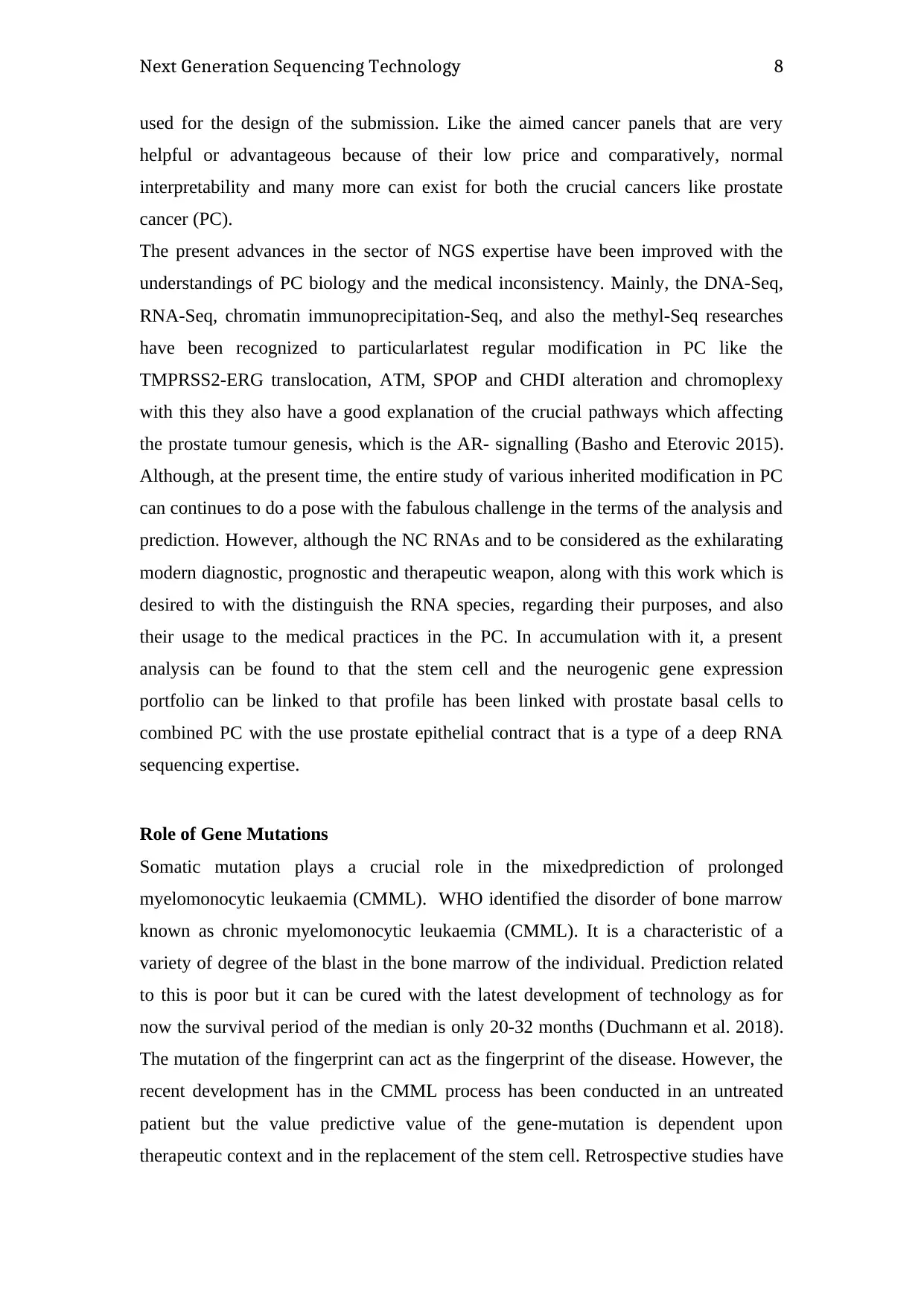
Next Generation Sequencing Technology
used for the design of the submission. Like the aimed cancer panels that are very
helpful or advantageous because of their low price and comparatively, normal
interpretability and many more can exist for both the crucial cancers like prostate
cancer (PC).
The present advances in the sector of NGS expertise have been improved with the
understandings of PC biology and the medical inconsistency. Mainly, the DNA-Seq,
RNA-Seq, chromatin immunoprecipitation-Seq, and also the methyl-Seq researches
have been recognized to particularlatest regular modification in PC like the
TMPRSS2-ERG translocation, ATM, SPOP and CHDI alteration and chromoplexy
with this they also have a good explanation of the crucial pathways which affecting
the prostate tumour genesis, which is the AR- signalling (Basho and Eterovic 2015).
Although, at the present time, the entire study of various inherited modification in PC
can continues to do a pose with the fabulous challenge in the terms of the analysis and
prediction. However, although the NC RNAs and to be considered as the exhilarating
modern diagnostic, prognostic and therapeutic weapon, along with this work which is
desired to with the distinguish the RNA species, regarding their purposes, and also
their usage to the medical practices in the PC. In accumulation with it, a present
analysis can be found to that the stem cell and the neurogenic gene expression
portfolio can be linked to that profile has been linked with prostate basal cells to
combined PC with the use prostate epithelial contract that is a type of a deep RNA
sequencing expertise.
Role of Gene Mutations
Somatic mutation plays a crucial role in the mixedprediction of prolonged
myelomonocytic leukaemia (CMML). WHO identified the disorder of bone marrow
known as chronic myelomonocytic leukaemia (CMML). It is a characteristic of a
variety of degree of the blast in the bone marrow of the individual. Prediction related
to this is poor but it can be cured with the latest development of technology as for
now the survival period of the median is only 20-32 months (Duchmann et al. 2018).
The mutation of the fingerprint can act as the fingerprint of the disease. However, the
recent development has in the CMML process has been conducted in an untreated
patient but the value predictive value of the gene-mutation is dependent upon
therapeutic context and in the replacement of the stem cell. Retrospective studies have
8
used for the design of the submission. Like the aimed cancer panels that are very
helpful or advantageous because of their low price and comparatively, normal
interpretability and many more can exist for both the crucial cancers like prostate
cancer (PC).
The present advances in the sector of NGS expertise have been improved with the
understandings of PC biology and the medical inconsistency. Mainly, the DNA-Seq,
RNA-Seq, chromatin immunoprecipitation-Seq, and also the methyl-Seq researches
have been recognized to particularlatest regular modification in PC like the
TMPRSS2-ERG translocation, ATM, SPOP and CHDI alteration and chromoplexy
with this they also have a good explanation of the crucial pathways which affecting
the prostate tumour genesis, which is the AR- signalling (Basho and Eterovic 2015).
Although, at the present time, the entire study of various inherited modification in PC
can continues to do a pose with the fabulous challenge in the terms of the analysis and
prediction. However, although the NC RNAs and to be considered as the exhilarating
modern diagnostic, prognostic and therapeutic weapon, along with this work which is
desired to with the distinguish the RNA species, regarding their purposes, and also
their usage to the medical practices in the PC. In accumulation with it, a present
analysis can be found to that the stem cell and the neurogenic gene expression
portfolio can be linked to that profile has been linked with prostate basal cells to
combined PC with the use prostate epithelial contract that is a type of a deep RNA
sequencing expertise.
Role of Gene Mutations
Somatic mutation plays a crucial role in the mixedprediction of prolonged
myelomonocytic leukaemia (CMML). WHO identified the disorder of bone marrow
known as chronic myelomonocytic leukaemia (CMML). It is a characteristic of a
variety of degree of the blast in the bone marrow of the individual. Prediction related
to this is poor but it can be cured with the latest development of technology as for
now the survival period of the median is only 20-32 months (Duchmann et al. 2018).
The mutation of the fingerprint can act as the fingerprint of the disease. However, the
recent development has in the CMML process has been conducted in an untreated
patient but the value predictive value of the gene-mutation is dependent upon
therapeutic context and in the replacement of the stem cell. Retrospective studies have
8
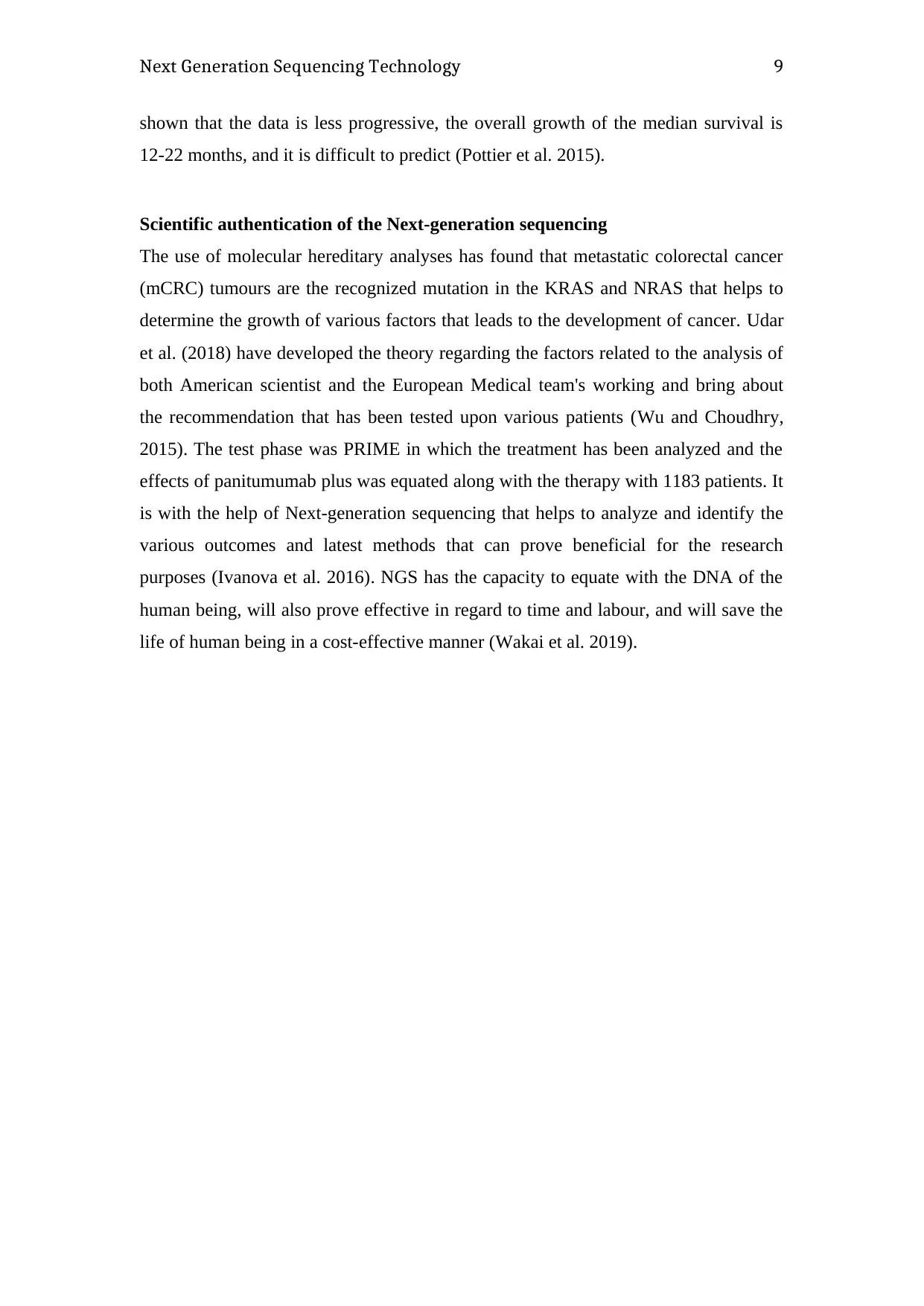
Next Generation Sequencing Technology
shown that the data is less progressive, the overall growth of the median survival is
12-22 months, and it is difficult to predict (Pottier et al. 2015).
Scientific authentication of the Next-generation sequencing
The use of molecular hereditary analyses has found that metastatic colorectal cancer
(mCRC) tumours are the recognized mutation in the KRAS and NRAS that helps to
determine the growth of various factors that leads to the development of cancer. Udar
et al. (2018) have developed the theory regarding the factors related to the analysis of
both American scientist and the European Medical team's working and bring about
the recommendation that has been tested upon various patients (Wu and Choudhry,
2015). The test phase was PRIME in which the treatment has been analyzed and the
effects of panitumumab plus was equated along with the therapy with 1183 patients. It
is with the help of Next-generation sequencing that helps to analyze and identify the
various outcomes and latest methods that can prove beneficial for the research
purposes (Ivanova et al. 2016). NGS has the capacity to equate with the DNA of the
human being, will also prove effective in regard to time and labour, and will save the
life of human being in a cost-effective manner (Wakai et al. 2019).
9
shown that the data is less progressive, the overall growth of the median survival is
12-22 months, and it is difficult to predict (Pottier et al. 2015).
Scientific authentication of the Next-generation sequencing
The use of molecular hereditary analyses has found that metastatic colorectal cancer
(mCRC) tumours are the recognized mutation in the KRAS and NRAS that helps to
determine the growth of various factors that leads to the development of cancer. Udar
et al. (2018) have developed the theory regarding the factors related to the analysis of
both American scientist and the European Medical team's working and bring about
the recommendation that has been tested upon various patients (Wu and Choudhry,
2015). The test phase was PRIME in which the treatment has been analyzed and the
effects of panitumumab plus was equated along with the therapy with 1183 patients. It
is with the help of Next-generation sequencing that helps to analyze and identify the
various outcomes and latest methods that can prove beneficial for the research
purposes (Ivanova et al. 2016). NGS has the capacity to equate with the DNA of the
human being, will also prove effective in regard to time and labour, and will save the
life of human being in a cost-effective manner (Wakai et al. 2019).
9
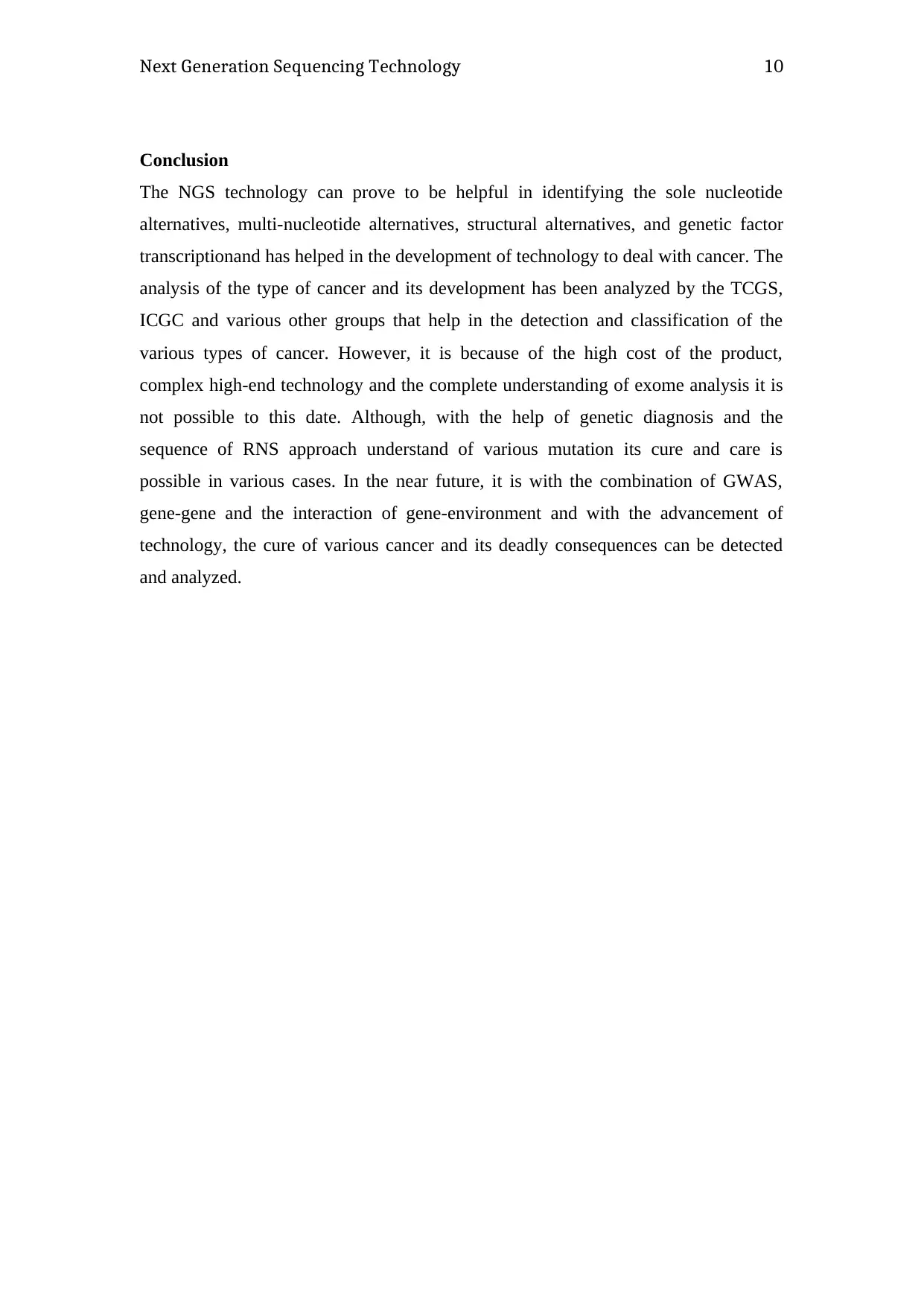
Next Generation Sequencing Technology
Conclusion
The NGS technology can prove to be helpful in identifying the sole nucleotide
alternatives, multi-nucleotide alternatives, structural alternatives, and genetic factor
transcriptionand has helped in the development of technology to deal with cancer. The
analysis of the type of cancer and its development has been analyzed by the TCGS,
ICGC and various other groups that help in the detection and classification of the
various types of cancer. However, it is because of the high cost of the product,
complex high-end technology and the complete understanding of exome analysis it is
not possible to this date. Although, with the help of genetic diagnosis and the
sequence of RNS approach understand of various mutation its cure and care is
possible in various cases. In the near future, it is with the combination of GWAS,
gene-gene and the interaction of gene-environment and with the advancement of
technology, the cure of various cancer and its deadly consequences can be detected
and analyzed.
10
Conclusion
The NGS technology can prove to be helpful in identifying the sole nucleotide
alternatives, multi-nucleotide alternatives, structural alternatives, and genetic factor
transcriptionand has helped in the development of technology to deal with cancer. The
analysis of the type of cancer and its development has been analyzed by the TCGS,
ICGC and various other groups that help in the detection and classification of the
various types of cancer. However, it is because of the high cost of the product,
complex high-end technology and the complete understanding of exome analysis it is
not possible to this date. Although, with the help of genetic diagnosis and the
sequence of RNS approach understand of various mutation its cure and care is
possible in various cases. In the near future, it is with the combination of GWAS,
gene-gene and the interaction of gene-environment and with the advancement of
technology, the cure of various cancer and its deadly consequences can be detected
and analyzed.
10
Secure Best Marks with AI Grader
Need help grading? Try our AI Grader for instant feedback on your assignments.
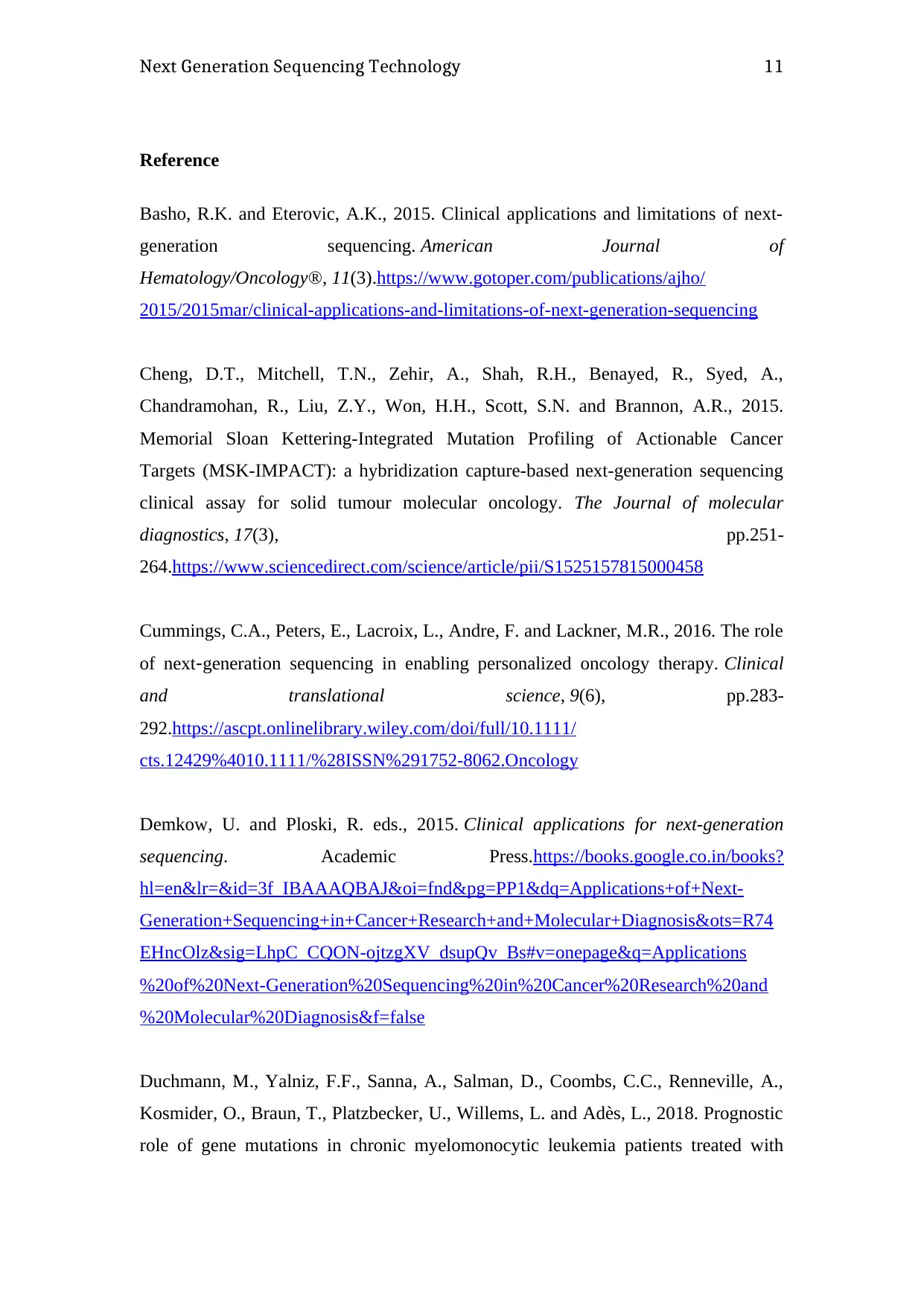
Next Generation Sequencing Technology
Reference
Basho, R.K. and Eterovic, A.K., 2015. Clinical applications and limitations of next-
generation sequencing. American Journal of
Hematology/Oncology®, 11(3).https://www.gotoper.com/publications/ajho/
2015/2015mar/clinical-applications-and-limitations-of-next-generation-sequencing
Cheng, D.T., Mitchell, T.N., Zehir, A., Shah, R.H., Benayed, R., Syed, A.,
Chandramohan, R., Liu, Z.Y., Won, H.H., Scott, S.N. and Brannon, A.R., 2015.
Memorial Sloan Kettering-Integrated Mutation Profiling of Actionable Cancer
Targets (MSK-IMPACT): a hybridization capture-based next-generation sequencing
clinical assay for solid tumour molecular oncology. The Journal of molecular
diagnostics, 17(3), pp.251-
264.https://www.sciencedirect.com/science/article/pii/S1525157815000458
Cummings, C.A., Peters, E., Lacroix, L., Andre, F. and Lackner, M.R., 2016. The role
of next‐generation sequencing in enabling personalized oncology therapy. Clinical
and translational science, 9(6), pp.283-
292.https://ascpt.onlinelibrary.wiley.com/doi/full/10.1111/
cts.12429%4010.1111/%28ISSN%291752-8062.Oncology
Demkow, U. and Ploski, R. eds., 2015. Clinical applications for next-generation
sequencing. Academic Press.https://books.google.co.in/books?
hl=en&lr=&id=3f_IBAAAQBAJ&oi=fnd&pg=PP1&dq=Applications+of+Next-
Generation+Sequencing+in+Cancer+Research+and+Molecular+Diagnosis&ots=R74
EHncOlz&sig=LhpC_CQON-ojtzgXV_dsupQv_Bs#v=onepage&q=Applications
%20of%20Next-Generation%20Sequencing%20in%20Cancer%20Research%20and
%20Molecular%20Diagnosis&f=false
Duchmann, M., Yalniz, F.F., Sanna, A., Salman, D., Coombs, C.C., Renneville, A.,
Kosmider, O., Braun, T., Platzbecker, U., Willems, L. and Adès, L., 2018. Prognostic
role of gene mutations in chronic myelomonocytic leukemia patients treated with
11
Reference
Basho, R.K. and Eterovic, A.K., 2015. Clinical applications and limitations of next-
generation sequencing. American Journal of
Hematology/Oncology®, 11(3).https://www.gotoper.com/publications/ajho/
2015/2015mar/clinical-applications-and-limitations-of-next-generation-sequencing
Cheng, D.T., Mitchell, T.N., Zehir, A., Shah, R.H., Benayed, R., Syed, A.,
Chandramohan, R., Liu, Z.Y., Won, H.H., Scott, S.N. and Brannon, A.R., 2015.
Memorial Sloan Kettering-Integrated Mutation Profiling of Actionable Cancer
Targets (MSK-IMPACT): a hybridization capture-based next-generation sequencing
clinical assay for solid tumour molecular oncology. The Journal of molecular
diagnostics, 17(3), pp.251-
264.https://www.sciencedirect.com/science/article/pii/S1525157815000458
Cummings, C.A., Peters, E., Lacroix, L., Andre, F. and Lackner, M.R., 2016. The role
of next‐generation sequencing in enabling personalized oncology therapy. Clinical
and translational science, 9(6), pp.283-
292.https://ascpt.onlinelibrary.wiley.com/doi/full/10.1111/
cts.12429%4010.1111/%28ISSN%291752-8062.Oncology
Demkow, U. and Ploski, R. eds., 2015. Clinical applications for next-generation
sequencing. Academic Press.https://books.google.co.in/books?
hl=en&lr=&id=3f_IBAAAQBAJ&oi=fnd&pg=PP1&dq=Applications+of+Next-
Generation+Sequencing+in+Cancer+Research+and+Molecular+Diagnosis&ots=R74
EHncOlz&sig=LhpC_CQON-ojtzgXV_dsupQv_Bs#v=onepage&q=Applications
%20of%20Next-Generation%20Sequencing%20in%20Cancer%20Research%20and
%20Molecular%20Diagnosis&f=false
Duchmann, M., Yalniz, F.F., Sanna, A., Salman, D., Coombs, C.C., Renneville, A.,
Kosmider, O., Braun, T., Platzbecker, U., Willems, L. and Adès, L., 2018. Prognostic
role of gene mutations in chronic myelomonocytic leukemia patients treated with
11
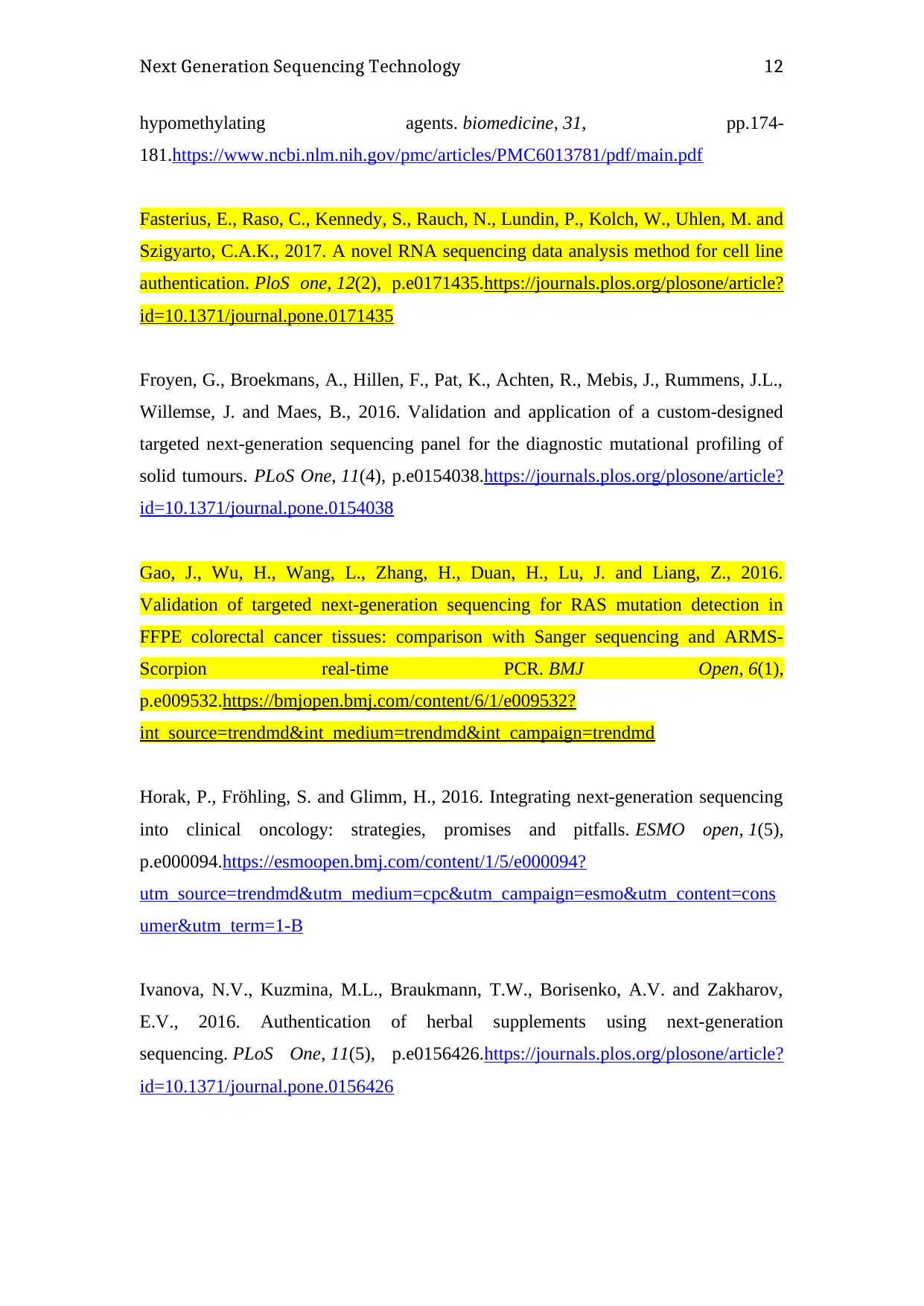
Next Generation Sequencing Technology
hypomethylating agents. biomedicine, 31, pp.174-
181.https://www.ncbi.nlm.nih.gov/pmc/articles/PMC6013781/pdf/main.pdf
Fasterius, E., Raso, C., Kennedy, S., Rauch, N., Lundin, P., Kolch, W., Uhlen, M. and
Szigyarto, C.A.K., 2017. A novel RNA sequencing data analysis method for cell line
authentication. PloS one, 12(2), p.e0171435.https://journals.plos.org/plosone/article?
id=10.1371/journal.pone.0171435
Froyen, G., Broekmans, A., Hillen, F., Pat, K., Achten, R., Mebis, J., Rummens, J.L.,
Willemse, J. and Maes, B., 2016. Validation and application of a custom-designed
targeted next-generation sequencing panel for the diagnostic mutational profiling of
solid tumours. PLoS One, 11(4), p.e0154038.https://journals.plos.org/plosone/article?
id=10.1371/journal.pone.0154038
Gao, J., Wu, H., Wang, L., Zhang, H., Duan, H., Lu, J. and Liang, Z., 2016.
Validation of targeted next-generation sequencing for RAS mutation detection in
FFPE colorectal cancer tissues: comparison with Sanger sequencing and ARMS-
Scorpion real-time PCR. BMJ Open, 6(1),
p.e009532.https://bmjopen.bmj.com/content/6/1/e009532?
int_source=trendmd&int_medium=trendmd&int_campaign=trendmd
Horak, P., Fröhling, S. and Glimm, H., 2016. Integrating next-generation sequencing
into clinical oncology: strategies, promises and pitfalls. ESMO open, 1(5),
p.e000094.https://esmoopen.bmj.com/content/1/5/e000094?
utm_source=trendmd&utm_medium=cpc&utm_campaign=esmo&utm_content=cons
umer&utm_term=1-B
Ivanova, N.V., Kuzmina, M.L., Braukmann, T.W., Borisenko, A.V. and Zakharov,
E.V., 2016. Authentication of herbal supplements using next-generation
sequencing. PLoS One, 11(5), p.e0156426.https://journals.plos.org/plosone/article?
id=10.1371/journal.pone.0156426
12
hypomethylating agents. biomedicine, 31, pp.174-
181.https://www.ncbi.nlm.nih.gov/pmc/articles/PMC6013781/pdf/main.pdf
Fasterius, E., Raso, C., Kennedy, S., Rauch, N., Lundin, P., Kolch, W., Uhlen, M. and
Szigyarto, C.A.K., 2017. A novel RNA sequencing data analysis method for cell line
authentication. PloS one, 12(2), p.e0171435.https://journals.plos.org/plosone/article?
id=10.1371/journal.pone.0171435
Froyen, G., Broekmans, A., Hillen, F., Pat, K., Achten, R., Mebis, J., Rummens, J.L.,
Willemse, J. and Maes, B., 2016. Validation and application of a custom-designed
targeted next-generation sequencing panel for the diagnostic mutational profiling of
solid tumours. PLoS One, 11(4), p.e0154038.https://journals.plos.org/plosone/article?
id=10.1371/journal.pone.0154038
Gao, J., Wu, H., Wang, L., Zhang, H., Duan, H., Lu, J. and Liang, Z., 2016.
Validation of targeted next-generation sequencing for RAS mutation detection in
FFPE colorectal cancer tissues: comparison with Sanger sequencing and ARMS-
Scorpion real-time PCR. BMJ Open, 6(1),
p.e009532.https://bmjopen.bmj.com/content/6/1/e009532?
int_source=trendmd&int_medium=trendmd&int_campaign=trendmd
Horak, P., Fröhling, S. and Glimm, H., 2016. Integrating next-generation sequencing
into clinical oncology: strategies, promises and pitfalls. ESMO open, 1(5),
p.e000094.https://esmoopen.bmj.com/content/1/5/e000094?
utm_source=trendmd&utm_medium=cpc&utm_campaign=esmo&utm_content=cons
umer&utm_term=1-B
Ivanova, N.V., Kuzmina, M.L., Braukmann, T.W., Borisenko, A.V. and Zakharov,
E.V., 2016. Authentication of herbal supplements using next-generation
sequencing. PLoS One, 11(5), p.e0156426.https://journals.plos.org/plosone/article?
id=10.1371/journal.pone.0156426
12
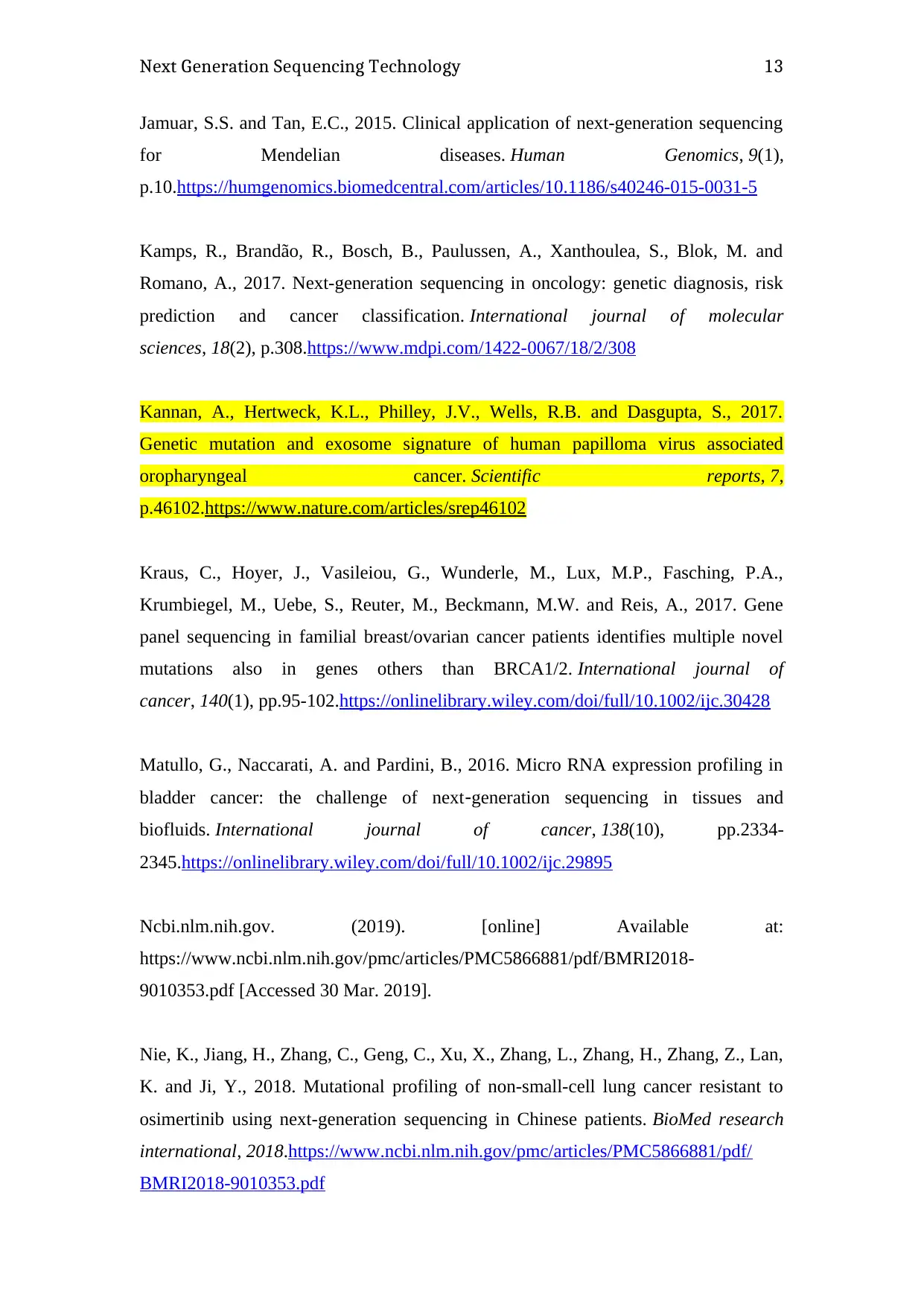
Next Generation Sequencing Technology
Jamuar, S.S. and Tan, E.C., 2015. Clinical application of next-generation sequencing
for Mendelian diseases. Human Genomics, 9(1),
p.10.https://humgenomics.biomedcentral.com/articles/10.1186/s40246-015-0031-5
Kamps, R., Brandão, R., Bosch, B., Paulussen, A., Xanthoulea, S., Blok, M. and
Romano, A., 2017. Next-generation sequencing in oncology: genetic diagnosis, risk
prediction and cancer classification. International journal of molecular
sciences, 18(2), p.308.https://www.mdpi.com/1422-0067/18/2/308
Kannan, A., Hertweck, K.L., Philley, J.V., Wells, R.B. and Dasgupta, S., 2017.
Genetic mutation and exosome signature of human papilloma virus associated
oropharyngeal cancer. Scientific reports, 7,
p.46102.https://www.nature.com/articles/srep46102
Kraus, C., Hoyer, J., Vasileiou, G., Wunderle, M., Lux, M.P., Fasching, P.A.,
Krumbiegel, M., Uebe, S., Reuter, M., Beckmann, M.W. and Reis, A., 2017. Gene
panel sequencing in familial breast/ovarian cancer patients identifies multiple novel
mutations also in genes others than BRCA1/2. International journal of
cancer, 140(1), pp.95-102.https://onlinelibrary.wiley.com/doi/full/10.1002/ijc.30428
Matullo, G., Naccarati, A. and Pardini, B., 2016. Micro RNA expression profiling in
bladder cancer: the challenge of next‐generation sequencing in tissues and
biofluids. International journal of cancer, 138(10), pp.2334-
2345.https://onlinelibrary.wiley.com/doi/full/10.1002/ijc.29895
Ncbi.nlm.nih.gov. (2019). [online] Available at:
https://www.ncbi.nlm.nih.gov/pmc/articles/PMC5866881/pdf/BMRI2018-
9010353.pdf [Accessed 30 Mar. 2019].
Nie, K., Jiang, H., Zhang, C., Geng, C., Xu, X., Zhang, L., Zhang, H., Zhang, Z., Lan,
K. and Ji, Y., 2018. Mutational profiling of non-small-cell lung cancer resistant to
osimertinib using next-generation sequencing in Chinese patients. BioMed research
international, 2018.https://www.ncbi.nlm.nih.gov/pmc/articles/PMC5866881/pdf/
BMRI2018-9010353.pdf
13
Jamuar, S.S. and Tan, E.C., 2015. Clinical application of next-generation sequencing
for Mendelian diseases. Human Genomics, 9(1),
p.10.https://humgenomics.biomedcentral.com/articles/10.1186/s40246-015-0031-5
Kamps, R., Brandão, R., Bosch, B., Paulussen, A., Xanthoulea, S., Blok, M. and
Romano, A., 2017. Next-generation sequencing in oncology: genetic diagnosis, risk
prediction and cancer classification. International journal of molecular
sciences, 18(2), p.308.https://www.mdpi.com/1422-0067/18/2/308
Kannan, A., Hertweck, K.L., Philley, J.V., Wells, R.B. and Dasgupta, S., 2017.
Genetic mutation and exosome signature of human papilloma virus associated
oropharyngeal cancer. Scientific reports, 7,
p.46102.https://www.nature.com/articles/srep46102
Kraus, C., Hoyer, J., Vasileiou, G., Wunderle, M., Lux, M.P., Fasching, P.A.,
Krumbiegel, M., Uebe, S., Reuter, M., Beckmann, M.W. and Reis, A., 2017. Gene
panel sequencing in familial breast/ovarian cancer patients identifies multiple novel
mutations also in genes others than BRCA1/2. International journal of
cancer, 140(1), pp.95-102.https://onlinelibrary.wiley.com/doi/full/10.1002/ijc.30428
Matullo, G., Naccarati, A. and Pardini, B., 2016. Micro RNA expression profiling in
bladder cancer: the challenge of next‐generation sequencing in tissues and
biofluids. International journal of cancer, 138(10), pp.2334-
2345.https://onlinelibrary.wiley.com/doi/full/10.1002/ijc.29895
Ncbi.nlm.nih.gov. (2019). [online] Available at:
https://www.ncbi.nlm.nih.gov/pmc/articles/PMC5866881/pdf/BMRI2018-
9010353.pdf [Accessed 30 Mar. 2019].
Nie, K., Jiang, H., Zhang, C., Geng, C., Xu, X., Zhang, L., Zhang, H., Zhang, Z., Lan,
K. and Ji, Y., 2018. Mutational profiling of non-small-cell lung cancer resistant to
osimertinib using next-generation sequencing in Chinese patients. BioMed research
international, 2018.https://www.ncbi.nlm.nih.gov/pmc/articles/PMC5866881/pdf/
BMRI2018-9010353.pdf
13
Paraphrase This Document
Need a fresh take? Get an instant paraphrase of this document with our AI Paraphraser
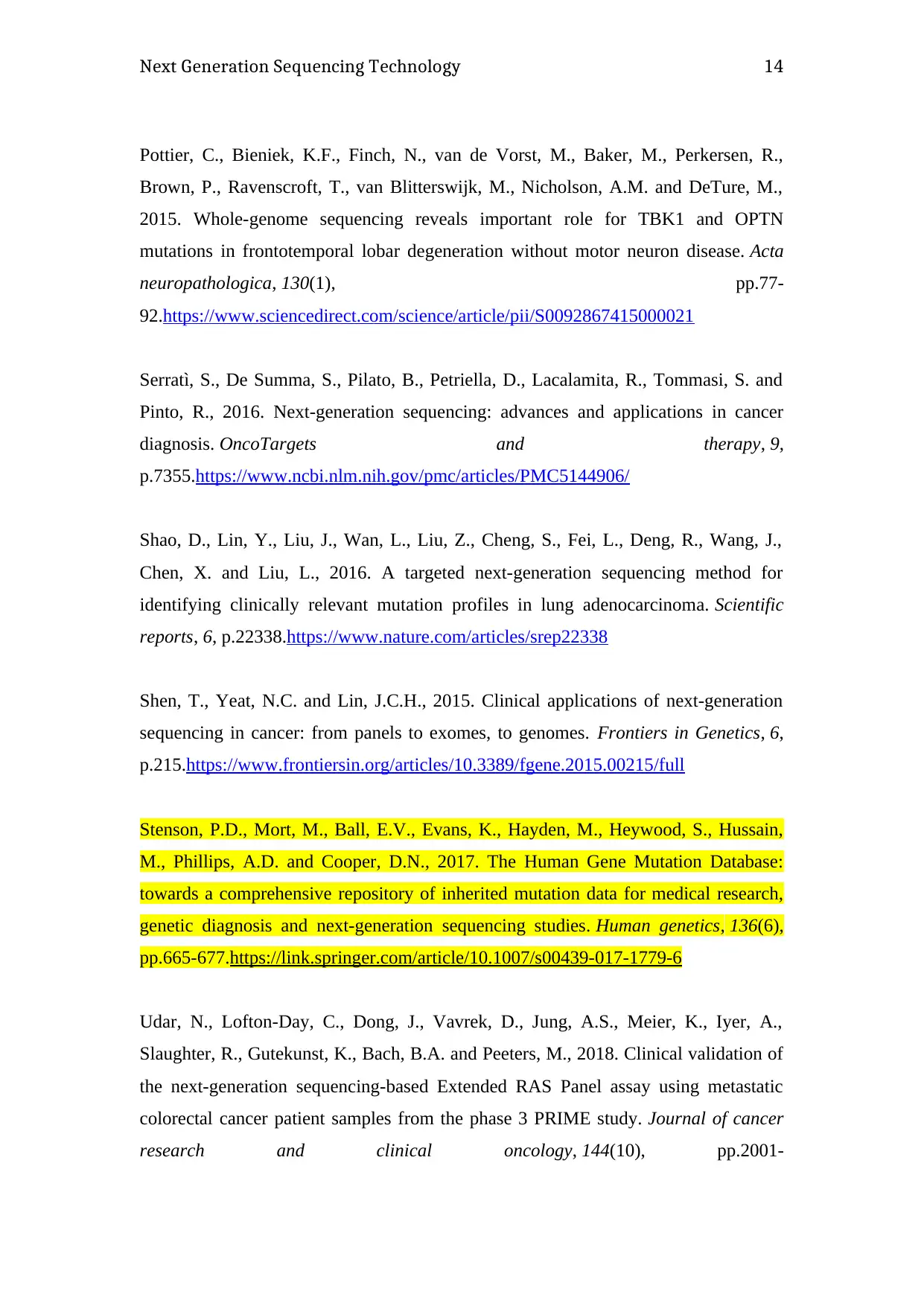
Next Generation Sequencing Technology
Pottier, C., Bieniek, K.F., Finch, N., van de Vorst, M., Baker, M., Perkersen, R.,
Brown, P., Ravenscroft, T., van Blitterswijk, M., Nicholson, A.M. and DeTure, M.,
2015. Whole-genome sequencing reveals important role for TBK1 and OPTN
mutations in frontotemporal lobar degeneration without motor neuron disease. Acta
neuropathologica, 130(1), pp.77-
92.https://www.sciencedirect.com/science/article/pii/S0092867415000021
Serratì, S., De Summa, S., Pilato, B., Petriella, D., Lacalamita, R., Tommasi, S. and
Pinto, R., 2016. Next-generation sequencing: advances and applications in cancer
diagnosis. OncoTargets and therapy, 9,
p.7355.https://www.ncbi.nlm.nih.gov/pmc/articles/PMC5144906/
Shao, D., Lin, Y., Liu, J., Wan, L., Liu, Z., Cheng, S., Fei, L., Deng, R., Wang, J.,
Chen, X. and Liu, L., 2016. A targeted next-generation sequencing method for
identifying clinically relevant mutation profiles in lung adenocarcinoma. Scientific
reports, 6, p.22338.https://www.nature.com/articles/srep22338
Shen, T., Yeat, N.C. and Lin, J.C.H., 2015. Clinical applications of next-generation
sequencing in cancer: from panels to exomes, to genomes. Frontiers in Genetics, 6,
p.215.https://www.frontiersin.org/articles/10.3389/fgene.2015.00215/full
Stenson, P.D., Mort, M., Ball, E.V., Evans, K., Hayden, M., Heywood, S., Hussain,
M., Phillips, A.D. and Cooper, D.N., 2017. The Human Gene Mutation Database:
towards a comprehensive repository of inherited mutation data for medical research,
genetic diagnosis and next-generation sequencing studies. Human genetics, 136(6),
pp.665-677.https://link.springer.com/article/10.1007/s00439-017-1779-6
Udar, N., Lofton-Day, C., Dong, J., Vavrek, D., Jung, A.S., Meier, K., Iyer, A.,
Slaughter, R., Gutekunst, K., Bach, B.A. and Peeters, M., 2018. Clinical validation of
the next-generation sequencing-based Extended RAS Panel assay using metastatic
colorectal cancer patient samples from the phase 3 PRIME study. Journal of cancer
research and clinical oncology, 144(10), pp.2001-
14
Pottier, C., Bieniek, K.F., Finch, N., van de Vorst, M., Baker, M., Perkersen, R.,
Brown, P., Ravenscroft, T., van Blitterswijk, M., Nicholson, A.M. and DeTure, M.,
2015. Whole-genome sequencing reveals important role for TBK1 and OPTN
mutations in frontotemporal lobar degeneration without motor neuron disease. Acta
neuropathologica, 130(1), pp.77-
92.https://www.sciencedirect.com/science/article/pii/S0092867415000021
Serratì, S., De Summa, S., Pilato, B., Petriella, D., Lacalamita, R., Tommasi, S. and
Pinto, R., 2016. Next-generation sequencing: advances and applications in cancer
diagnosis. OncoTargets and therapy, 9,
p.7355.https://www.ncbi.nlm.nih.gov/pmc/articles/PMC5144906/
Shao, D., Lin, Y., Liu, J., Wan, L., Liu, Z., Cheng, S., Fei, L., Deng, R., Wang, J.,
Chen, X. and Liu, L., 2016. A targeted next-generation sequencing method for
identifying clinically relevant mutation profiles in lung adenocarcinoma. Scientific
reports, 6, p.22338.https://www.nature.com/articles/srep22338
Shen, T., Yeat, N.C. and Lin, J.C.H., 2015. Clinical applications of next-generation
sequencing in cancer: from panels to exomes, to genomes. Frontiers in Genetics, 6,
p.215.https://www.frontiersin.org/articles/10.3389/fgene.2015.00215/full
Stenson, P.D., Mort, M., Ball, E.V., Evans, K., Hayden, M., Heywood, S., Hussain,
M., Phillips, A.D. and Cooper, D.N., 2017. The Human Gene Mutation Database:
towards a comprehensive repository of inherited mutation data for medical research,
genetic diagnosis and next-generation sequencing studies. Human genetics, 136(6),
pp.665-677.https://link.springer.com/article/10.1007/s00439-017-1779-6
Udar, N., Lofton-Day, C., Dong, J., Vavrek, D., Jung, A.S., Meier, K., Iyer, A.,
Slaughter, R., Gutekunst, K., Bach, B.A. and Peeters, M., 2018. Clinical validation of
the next-generation sequencing-based Extended RAS Panel assay using metastatic
colorectal cancer patient samples from the phase 3 PRIME study. Journal of cancer
research and clinical oncology, 144(10), pp.2001-
14

Next Generation Sequencing Technology
2010.https://www.ncbi.nlm.nih.gov/pmc/articles/PMC6153611/pdf/
432_2018_Article_2688.pdf
Wakai, T., Prasoon, P., Hirose, Y., Shimada, Y., Ichikawa, H. and Nagahashi, M.,
2019. Next-generation sequencing-based clinical sequencing: toward precision
medicine in solid tumors. International journal of clinical oncology, 24(2), pp.115-
122.https://link.springer.com/article/10.1007/s10147-018-1375-3
Wu, W. and Choudhry, H. eds., 2015. Next Generation Sequencing in Cancer
Research, Volume 2: From Basepairs to Bedsides.
Springer.https://link.springer.com/book/10.1007%2F978-3-319-15811-2
15
2010.https://www.ncbi.nlm.nih.gov/pmc/articles/PMC6153611/pdf/
432_2018_Article_2688.pdf
Wakai, T., Prasoon, P., Hirose, Y., Shimada, Y., Ichikawa, H. and Nagahashi, M.,
2019. Next-generation sequencing-based clinical sequencing: toward precision
medicine in solid tumors. International journal of clinical oncology, 24(2), pp.115-
122.https://link.springer.com/article/10.1007/s10147-018-1375-3
Wu, W. and Choudhry, H. eds., 2015. Next Generation Sequencing in Cancer
Research, Volume 2: From Basepairs to Bedsides.
Springer.https://link.springer.com/book/10.1007%2F978-3-319-15811-2
15
1 out of 15
Related Documents
Your All-in-One AI-Powered Toolkit for Academic Success.
+13062052269
info@desklib.com
Available 24*7 on WhatsApp / Email
![[object Object]](/_next/static/media/star-bottom.7253800d.svg)
Unlock your academic potential
© 2024 | Zucol Services PVT LTD | All rights reserved.





